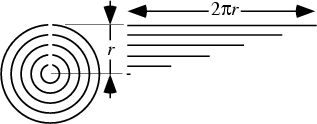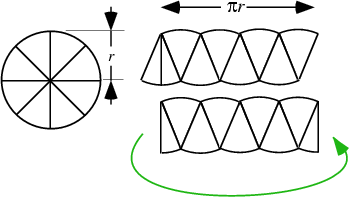| 释义 |
CircleA circle is the set of points equidistant from a given point  . The distance . The distance  from the Center is called theRadius, and the point from the Center is called theRadius, and the point  is called the Center. Twice the Radius is known as the Diameter is called the Center. Twice the Radius is known as the Diameter . The Perimeter . The Perimeter  of a circle is called the Circumference, and is given by of a circle is called the Circumference, and is given by
 | (1) |
 -D for -D for  a Hypersphere. a Hypersphere.
The region of intersection of two circles is called a Lens. The region of intersection of three symmetricallyplaced circles (as in a Venn Diagram), in the special case of the center of each being located at the intersectionof the other two, is called a Reuleaux Triangle.
The parametric equations for a circle of Radius  are are
For a body moving uniformly around the circle,
and
When normalized, the former gives the equation for the unit Tangent Vector of the circle,  .The circle can also be parameterized by the rational functions .The circle can also be parameterized by the rational functions
but an Elliptic Curve cannot. The following plots show a sequence of Normal andTangent Vectors for the circle.
The Arc Length  , Curvature , Curvature  , and Tangential Angle , and Tangential Angle  of the circle are of the circle are
The Cesàro Equation is
 | (13) |
In Polar Coordinates, the equation of the circle has a particularly simple form.
 | (14) |
 centered at Origin, centered at Origin,
 | (15) |
 centered at centered at  , and , and
 | (16) |
 centered on centered on  . In Cartesian Coordinates, the equation of a circle ofRadius . In Cartesian Coordinates, the equation of a circle ofRadius  centered on centered on  is is
 | (17) |
 | (18) |
 as a diameter is given by as a diameter is given by
 | (19) |
The equation of a circle passing through the three points  for for  , 2, 3 (the Circumcircle of theTriangle determined by the points) is , 2, 3 (the Circumcircle of theTriangle determined by the points) is
 | (20) |
 | (21) |
 and and  (since there is no (since there is no  cross term). Completing the Square gives cross term). Completing the Square gives
 | (22) |
and the Radius as
 | (25) |
Four or more points which lie on a circle are said to be Concyclic. Three points are trivially concyclic sincethree noncollinear points determine a circle.
The Circumference-to-Diameter ratio  for a circle is constant as the size of the circle is changed (asit must be since scaling a plane figure by a factor for a circle is constant as the size of the circle is changed (asit must be since scaling a plane figure by a factor  increases its Perimeter by increases its Perimeter by  ), and ), and  also scales by also scales by . This ratio is denoted . This ratio is denoted  (Pi), and has been proved Transcendental.With (Pi), and has been proved Transcendental.With  the Diameter and the Diameter and  the Radius, the Radius,
 | (30) |
 , we can then compute the Area of the circle either geometrically or using Calculus. FromCalculus, , we can then compute the Area of the circle either geometrically or using Calculus. FromCalculus,
 | (31) |
Now for a few geometrical derivations. Using concentric strips, we have As the number of strips increases to infinity, we are left with a Triangle on the right, so
 | (32) |
 in Measurement of a Circle (ca. 225 BC in Measurement of a Circle (ca. 225 BC  ). If wecut the circle instead into wedges, ). If wecut the circle instead into wedges,As the number of wedges increases to infinity, we are left with a Rectangle, so
 | (33) |
References
Beyer, W. H. CRC Standard Mathematical Tables, 28th ed. Boca Raton, FL: CRC Press, pp. 125 and 197, 1987.Casey, J. ``The Circle.'' Ch. 3 in A Treatise on the Analytical Geometry of the Point, Line, Circle, and Conic Sections, Containing an Account of Its Most Recent Extensions, with Numerous Examples, 2nd ed., rev. enl. Dublin: Hodges, Figgis, & Co., pp. 96-150, 1893. Courant, R. and Robbins, H. What is Mathematics?: An Elementary Approach to Ideas and Methods, 2nd ed. Oxford, England: Oxford University Press, pp. 74-75, 1996. Dunham, W. ``Archimedes' Determination of Circular Area.'' Ch. 4 in Journey Through Genius: The Great Theorems of Mathematics. New York: Wiley, pp. 84-112, 1990. Eppstein, D. ``Circles and Spheres.''http://www.ics.uci.edu/~eppstein/junkyard/sphere.html. Lawrence, J. D. A Catalog of Special Plane Curves. New York: Dover, pp. 65-66, 1972. MacTutor History of Mathematics Archive. ``Circle.''http://www-groups.dcs.st-and.ac.uk/~history/Curves/Circle.html. Pappas, T. ``Infinity & the Circle'' and ``Japanese Calculus.'' The Joy of Mathematics. San Carlos, CA: Wide World Publ./Tetra, pp. 68 and 139, 1989. Pedoe, D. Circles: A Mathematical View, rev. ed. Washington, DC: Math. Assoc. Amer., 1995. Yates, R. C. ``The Circle.'' A Handbook on Curves and Their Properties. Ann Arbor, MI: J. W. Edwards, pp. 21-25, 1952.
|

![]() . The distance
. The distance ![]() from the Center is called theRadius, and the point
from the Center is called theRadius, and the point ![]() is called the Center. Twice the Radius is known as the Diameter
is called the Center. Twice the Radius is known as the Diameter![]() . The Perimeter
. The Perimeter ![]() of a circle is called the Circumference, and is given by
of a circle is called the Circumference, and is given by![]() are
are

![]() , Curvature
, Curvature ![]() , and Tangential Angle
, and Tangential Angle ![]() of the circle are
of the circle are


![]() for
for ![]() , 2, 3 (the Circumcircle of theTriangle determined by the points) is
, 2, 3 (the Circumcircle of theTriangle determined by the points) is




![]() for a circle is constant as the size of the circle is changed (asit must be since scaling a plane figure by a factor
for a circle is constant as the size of the circle is changed (asit must be since scaling a plane figure by a factor ![]() increases its Perimeter by
increases its Perimeter by ![]() ), and
), and ![]() also scales by
also scales by![]() . This ratio is denoted
. This ratio is denoted ![]() (Pi), and has been proved Transcendental.With
(Pi), and has been proved Transcendental.With ![]() the Diameter and
the Diameter and ![]() the Radius,
the Radius,
